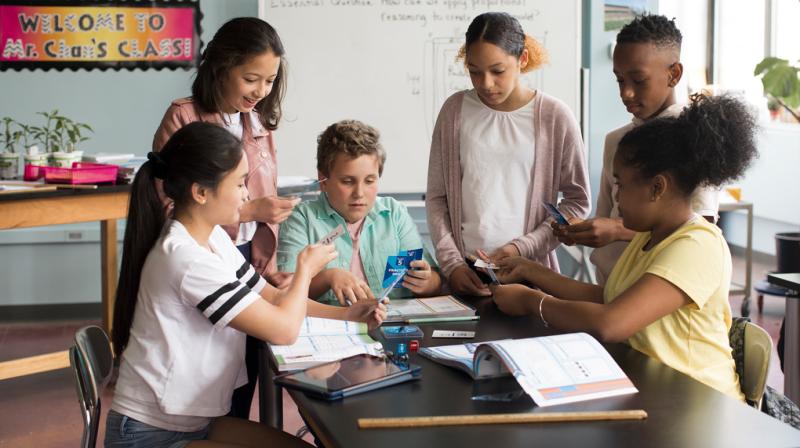Both collaborative learning and group work require students to work together to attain a common objective. However, they differ significantly in purpose, structure, and outcomes. The primary distinction between approaches rests in their respective goals. Collaborative learning focuses on cultivating students’ profound comprehension, critical thinking, and problem-solving skills by emphasising exchanging ideas and information. Students gain knowledge from one another and contribute equitably, enhancing one another’s strengths. In contrast, group work is frequently more focused on completing a specific task or project than gaining a deeper comprehension of the subject matter.
Additionally, the structure of these approaches differs. Collaborative learning necessitates active participation, a high degree of interdependence, and shared responsibility from all members. Ensuring all students contribute equally frequently entails meticulously planned activities and assigned roles. On the other hand, group work can occasionally result in an uneven distribution of responsibilities, with some members dominating the process while others play a more passive role.
Collaborative learning seeks to cultivate higher-order thinking skills, encourage social interaction, and improve individual learning through engagement with diverse perspectives. The intended outcomes of these approaches also vary. The primary outcome of group work is the successful completion of a task or project; individual learning and developing critical thinking skills are not necessarily the focus. In short, although collaborative learning and group work involve students working together, they differ in purpose, structure, and intended outcomes, with collaborative learning emphasising knowledge construction, equal participation, skill development, and group work highlighting task completion.
What is Collaborative Learning?
Collaborative learning is a way of teaching that focuses on getting students to work together to learn and build knowledge actively. It is based on the idea that learning is a social process in which students can learn from their peers’ different points of view and experiences, improving their learning and brain growth. This helps students understand ideas better and improves their critical thinking and problem-solving skills. In collaborative learning, students are usually put into small, different groups. These groups often have roles and tasks that are carefully planned to ensure everyone takes part and shares responsibility. This method promotes interdependence, where each person’s input is essential to the group’s success. It also helps students learn how to listen, talk, and negotiate because they have to work together to reach a shared goal.
Collaborative learning is based on constructivist theories, which say people don’t passively get information but build it themselves by interacting with others and their environment. In this setting, students take charge of their learning by actively looking for information and making links between what they already know and what they are learning. Collaborative learning can help students improve in school, be more motivated, think critically, and improve their social and relationship skills. Students can better understand complicated problems, adapt to new situations, and become lifelong learners in a constantly changing world if they are exposed to different points of view.
What is Group Work?
Group work is a way to learn that involves putting students into small groups to work on a project or task together. The main goal of group work is to complete the given assignment. Individual learning and skill building are secondary goals. By working together in groups, students can use their resources, skills, and knowledge to reach a shared goal while learning to work as a team and communicate. In group work, students are often given different roles or responsibilities based on their skills or interests, hoping they will contribute to the group’s success. Group work can be done differently, from informal, ad-hoc teams to more organised, teacher-led groups with straightforward tasks and goals.
One of the best things about group work is that it allows students to learn from their peers, improve their social skills, and get used to working with people from different backgrounds. Group work can also motivate people because students often find it more exciting and fun than doing their work. But group work can also be challenging, like when not everyone takes part or when tasks aren’t shared equally. Some students may not learn as well because of these problems, especially if they are not actively involved in the group’s work or don’t have a chance to share their unique skills and views. In short, group work is a way of learning in which students work together to finish a task or project. The focus is on sharing resources, knowledge, and skills to reach a shared goal.
Difference Between Collaborative Learning and Group Work
Although collaborative learning and group work require students to work together, they are different. Equal participation, active engagement, and shared responsibility are cornerstones of the collaborative learning model, emphasising in-depth comprehension, knowledge production, and skill development. Group work focuses on completing a specific task or endeavour and frequently has a more pragmatic orientation. Unlike group work, which can lead to unequal involvement, collaborative learning activities are planned to encourage dependency on others. Unlike group work, which prioritises task completion over individual learning and skill development, collaborative learning fosters higher-order thinking skills and increases personal knowledge through varied views. The primary difference between the two is highlighted here.
Purpose
The goal of group work is to get something done, but the purpose of collaborative learning is to build knowledge and understanding together.
Learning Outcomes
While group work focuses on getting the job done as quickly as possible, collaborative learning promotes the development of higher-order thinking skills.
Participation
While group projects can lead to unequal participation contributions, collaborative learning promotes everyone’s involvement.
Structure
While group work sometimes lacks a clear framework, collaborative learning relies on predetermined activities and roles to foster cooperation.
Interaction
While group projects don’t always encourage participation, responsibility sharing, and socialisation, collaborative learning does.
Cognitive Development
Collaborative learning boosts individual learning through different points of view, although group work might not always be conducive to fostering intellectual growth.
Constructivist Theories
While group work often doesn’t follow the principles of constructivism, which underpins collaborative learning by emphasising active knowledge building, collaborative learning does.
Skill Development
Teamwork and task-oriented abilities are the primary goals of group work, while communication, negotiation, and problem-solving are the primary goals of collaborative learning.






